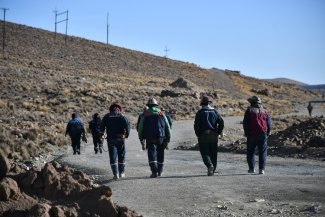Two toxic spills in one month have intensified the debate on the lack of inspection and control of multinational mining companies in Peru. The sequence of disasters has forced the country’s government to declare its intent to toughen sanctions on mining companies that destroy the environment and poison local communities.
On 29 August, tonnes of toxic waste polluted at least ten kilometres of the Huallaga, one of Peru’s largest rivers. The spill came from the Atacocha mine owned by the Brazilian multinational Votorantim.
The region’s inhabitants raised the alarm about the spill and a government delegation subsequently arrived on-site to investigate the accident. Peasant organisations warned in a press release, that the pollution had affected the flora, fauna, the riverbanks and the various villages dotted along the river.
The company has not issued a statement on the incident and the impact of the spill has still not been determined. Last year, the mining company earned US$ 134.8 million from their activities in Atacocha. Votorantim has investments in over 20 countries throughout the world, in mining, metallurgy and cement and concrete in particular.
The government had previously authorised the company to discharge waste products such as cyanide, selenium, mercury, cadmium, lead, zinc, arsenic, copper, iron, manganese, nickel and silver into the river.
Governmental authorities are working on the hypothesis that it was “human error” during the shift change which resulted in tonnes of toxic sludge escaping into the river.
Five weeks previously, at least 350 people, including 69 children, were poisoned when an explosion released 45 tonnes of copper into the atmosphere.
Witnesses reported hearing a loud bang followed by a toxic cloud which blanketed the area. The incident occurred on the 25 July in a pipeline close to Santa Rosa de Cajacay, a village with approximately 400 inhabitants, mainly Andean rural workers.
After the explosion, hundreds of people had to go to hospital suffering from respiratory tract bleeding, stomach pains, nausea and vomiting.
An analysis by Censopas, the state agency for health and the environment, reported that at least seven children and three adults from the area still had high levels of copper and lead in their bloodstream two weeks after the accident.
The installation is owned by the Antamina Mining Company, a joint venture between four giants in the sector with the majority of capital invested by the Anglo-Australian company, BHP Billiton, and the Anglo-Swiss company, Xstrata.
In 2011, Antamina earned US$ 3,384.3 million making them the most profitable mining operation in Peru. The company claimed that the explosion was an “unintentional act” and that a clean-up operation and a health facility have been set up in the area in response to the incident. The company stated that “working to ensure the health of all the inhabitants is our priority”
The government has launched investigations into the environmental impact of both disasters. Sanctions can only be applied when the results are available and when administrative proceedings have begun. This process generally takes several months.
According to the Minister for the Environment, Manuel Pulgar-Vidal, the government is studying ways to change the regulations so that they can already impose sanctions on the companies when the incidents actually take place. Official figures show 169 active social conflicts in Peru, the majority of which involve the mining industry. In August, a multi-million gold-mining project by the multinational Newmont Corporation in Cajamarca was suspended after months of protests by social groups, trade unions and indigenous communities.









